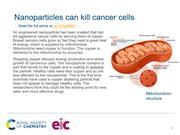Turning the cancer cell’s need for copper into a weapon against it
Download this
A starter slide to use with your 14–16 students and provide context for nanoparticles and their application in medicine: rsc.li/3gnyyZO

An engineered nanoparticle has been created that can kill aggressive cancer cells by starving them of copper. This is the first time researchers have used a copper depleting particle that does not appear to damage healthy cells. The team is confident that this could be the starting point for new, safer and more effective drugs.
A common feature of breast cancers is that they are more dependent on copper than healthy cells. As these aggressive cancers grow so fast, they need a great deal of energy – which is supplied by mitochondria, cells’ powerhouses. Mitochondria cannot function without copper as the element is vital for the electron transport chain that drives the production of adenosine triphosphate (ATP), the cell’s energy currency.
The nanoparticle has three main features: a copper-depleting part that binds to copper, a coating to stabilise the particle and a polymer matrix with optical properties that makes it easy to detect in the body.
Put this in context
Add context and highlight diverse careers with our short career videos showing how chemistry is making a difference and let your learners be inspired by chemists like Lewis, a bionanotechnology PhD student.
The team then administered the nanoparticle to mice with cancer and analysed its impact. They found that the mitochondria in cancer cells treated with the nanoparticle were compromised. The treatment downregulated key enzymes that deliver copper to mitochondria, interrupting copper trafficking and energy production. This resulted in cell death.
Use the starter slide with your class to give them a new context for their study of uses of nanoparticles.
Read the full story in Chemistry World.
Downloads
Nanoparticles kill cancer cells starter slide
Presentation | PDF, Size 0.1 mbNanoparticles kill cancer cells starter slide
Presentation | PowerPoint, Size 0.26 mb










No comments yet